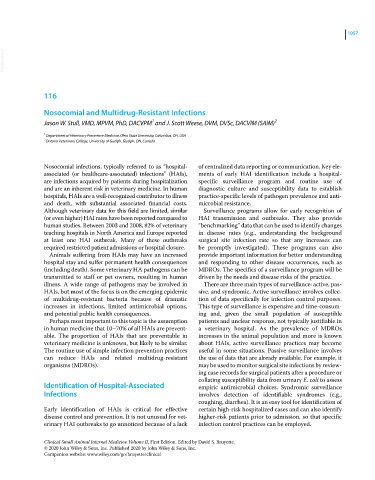Page 1119 - Clinical Small Animal Internal Medicine
P. 1119
1057
VetBooks.ir
116
Nosocomial and Multidrug‐Resistant Infections
1
Jason W. Stull, VMD, MPVM, PhD, DACVPM and J. Scott Weese, DVM, DVSc, DACVIM (SAIM) 2
1 Department of Veterinary Preventive Medicine, Ohio State University, Columbus, OH, USA
2 Ontario Veterinary College, University of Guelph, Guelph, ON, Canada
Nosocomial infections, typically referred to as “hospital‐ of centralized data reporting or communication. Key ele-
associated (or healthcare-associated) infections” (HAIs), ments of early HAI identification include a hospital‐
are infections acquired by patients during hospitalization specific surveillance program and routine use of
and are an inherent risk in veterinary medicine. In human diagnostic culture and susceptibility data to establish
hospitals, HAIs are a well‐recognized contributor to illness practice‐ specific levels of pathogen prevalence and anti-
and death, with substantial associated financial costs. microbial resistance.
Although veterinary data for this field are limited, similar Surveillance programs allow for early recognition of
(or even higher) HAI rates have been reported compared to HAI transmission and outbreaks. They also provide
human studies. Between 2003 and 2008, 82% of veterinary “benchmarking” data that can be used to identify changes
teaching hospitals in North America and Europe reported in disease rates (e.g., understanding the background
at least one HAI outbreak. Many of these outbreaks surgical site infection rate so that any increases can
required restricted patient admissions or hospital closure. be promptly investigated). These programs can also
Animals suffering from HAIs may have an increased provide important information for better understanding
hospital stay and suffer permanent health consequences and responding to other disease occurrences, such as
(including death). Some veterinary HA pathogens can be MDROs. The specifics of a surveillance program will be
transmitted to staff or pet owners, resulting in human driven by the needs and disease risks of the practice.
illness. A wide range of pathogens may be involved in There are three main types of surveillance: active, pas-
HAIs, but most of the focus is on the emerging epidemic sive, and syndromic. Active surveillance involves collec-
of multidrug‐resistant bacteria because of dramatic tion of data specifically for infection control purposes.
increases in infections, limited antimicrobial options, This type of surveillance is expensive and time‐consum-
and potential public health consequences. ing and, given the small population of susceptible
Perhaps most important to this topic is the assumption patients and unclear response, not typically justifiable in
in human medicine that 10–70% of all HAIs are prevent- a veterinary hospital. As the prevalence of MDROs
able. The proportion of HAIs that are preventable in increases in the animal population and more is known
veterinary medicine is unknown, but likely to be similar. about HAIs, active surveillance practices may become
The routine use of simple infection prevention practices useful in some situations. Passive surveillance involves
can reduce HAIs and related multidrug‐resistant the use of data that are already available. For example, it
organisms (MDROs). may be used to monitor surgical site infections by review-
ing case records for surgical patients after a procedure or
collating susceptibility data from urinary E. coli to assess
Identification of Hospital‐Associated empiric antimicrobial choices. Syndromic surveillance
Infections involves detection of identifiable syndromes (e.g.,
coughing, diarrhea). It is an easy tool for identification of
Early identification of HAIs is critical for effective certain high‐risk hospitalized cases and can also identify
disease control and prevention. It is not unusual for vet- higher‐risk patients prior to admission, so that specific
erinary HAI outbreaks to go unnoticed because of a lack infection control practices can be employed.
Clinical Small Animal Internal Medicine Volume II, First Edition. Edited by David S. Bruyette.
© 2020 John Wiley & Sons, Inc. Published 2020 by John Wiley & Sons, Inc.
Companion website: www.wiley.com/go/bruyette/clinical

